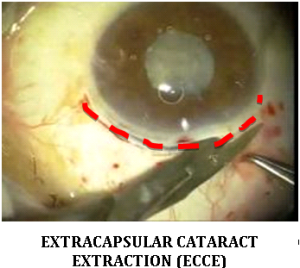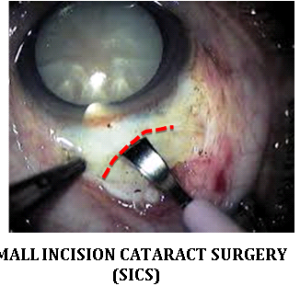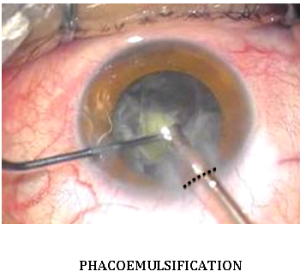Dr. Pattnaik’s Laser Eye Institute is fully equipped with the most modern technology for performing Sutureless Cataract surgeries. A new modular operation theatre with HEPA Filters and Laminar Flow has been made to maintain an infection free environment, as per the NABH Standards. We have also increased the capacity in our outpatient department (OPD) with streamlined system for consultation & investigation.
Cataract is the leading cause of decreased vision and blindness in our country. It can be cured by a simple cataract extraction microsurgery, which these days are performed using advanced Phacoemulsification technology in a short period of time and is done as a day care procedure.
We at Dr. Pattnaik’s Laser Eye Institute, have one of the world’s finest platforms for cataract surgery – AMO White Star and Ziess Visalis machines. Both these machines can be used for the latest Micro-Coaxial Cataract Surgery (MICS), or removal of the cataract through a 1.8 to 2 mm incision with the implantation of foldable intraocular lenses (IOLs). We offer our patients the latest in IOL technology including the accommodative Crystalens HD, the ReSTOR & Tecnis multifocal IOLs and the astigmatism correcting Toric IOLs. We offer the latest generation of multifocal IOLs with astigmatism correction and the Implantable Collamer Lens as an option in correcting refractive errors. To minimize calculation errors in the implanted IOLs we now have the Immersion Biometry, which works by the laser interferometry principle.
The most common type of cataract is related to ageing of the eye. Other causes of cataract include:
- Family history
- Medical problems, such as diabetes
- Injury to the eye
- Medications, especially steroids
- Radiation
- Long-term, unprotected exposure to sunlight
- Previous eye surgery
- Unknown factors
WHAT ARE THE SYMPTOMS OF CATARACT?
- Painless, gradually progressive blurring of vision.
- Double vision or seeing multiple images.
- Trouble with seeing in poor light conditions and sometimes in excessive sunlight.
- Becoming sensitive to glare, making night driving difficult.
- Difficulty in distance vision and in reading.
- Poor night vision
- Fading or yellowing of colors
WHEN DOES ONE GO IN FOR SURGERY?
- To a large extent is depends on the profession of person undergoing surgery. If you are a regular computer user or a reader then you start feeling blurring of vision even in very early stages of cataract and demand surgery. Some people don’t feel the need until their day-to-day activities don’t get hampered.
- Whenever the cataract affects vision to a degree that it hampers the person’s daily activities (reading, driving, playing golf etc.), surgery should be considered.
HOW LONG DOES THE LENS IMPLANTED IN THE EYE LAST?
- During surgery the normal lens of the eye is removed and replaced with an intra-ocular lens, which lasts for the entire lifetime.
WHAT ARE THE SURGICAL OPTIONS?
- Phacoemulsification is at present universally accepted as the standard of care for cataract surgery Ultrasound energy is used in phacoemulsification to break up the cataract (emulsify) into microscopic fragments, which can be sucked out of the eye.
- Surgery can be performed manually through 5- 6 mm wounds called SICS (Small Incision Cataract Surgery) or through a 1 cm incision by Extracapsular Cataract Extraction as shown in the pictures below.
What is MICS?
- The surgical wounds have progressively become smaller and now the latest technique is “Micro-coaxial Phacoemulsification” or MICS.
- MICS is phacoemulsification of the cataract through a wound of 1.8 to 2.2 mm or less, with implantation of an intra-ocular lens through the same wound.
- Wound healing and refractive stabilization is faster in MICS than in traditional phaco. Also, chances of developing Postoperative Astigmatism (Cylindrical power) are minimal.
Intra ocular lens can be rigid or foldable. Foldable lens will need smaller wounds to insert.
They can focus light rays from one particular distance only. Normally distance objects are clear and one needs glasses for reading. The majority of the IOLs implanted are mono-focal.
Multifocal IOLs have different segments built onto the same lens, which allows clear distance & near vision with freedom from glasses/ spectacles for most activities.
Traditionally used monofocal IOLs correct only the spherical refractive error. Patients with pre existing astigmatism will need spectacle correction for distance vision and near. Toric IOLs eliminates the need of glasses for distance. Recently multifocal IOLs have also been introduced with this option, thus correcting for distance, near and cylindrical error.
Astigmatism is a refractive error in which the curvature of the cornea is different in different meridia. The shape is more important to an American football rather than a regular football. People with astigmatism were earlier not suitable for multifocal IOLs. Now with the introduction of Toric Multifocal IOLs, it is possible to correct this astigmatism and also provide good near vision to this group of people.
A limitation of standard multifocal IOLs is that they provide good distance and near vision but have a somewhat compromised intermediate vision. This is the distance used for working on computers. Trifocal IOLs provide excellent vision not only for near and far, but also for intermediate distances.
IOL power calculation
Trained personnel do biometry or IOL power calculation and every effort is made to ensure accurate results. It requires measurement of the axial length (length of the eyeball) and corneal keratometry (power of the cornea). Axial length measurements are done using both laser and ultrasound technologies using different machines. This is done to avoid errors as much as possible. Corneal keratometry measurements prior to cataract surgery are calculated using an Autorefractometer and/ or IOL Master.
This also allows us to manage complex cases such as patients coming for cataract surgery after having undergone keratorefractive surgery (LASIK, PRK etc) or those with Keratoconus.
WHAT ARE THE PRE-OPERATIVE REQUIREMENTS?
- One needs to be in fairly good general health.
- Diabetes, hypertension, cardiac problems (if any) need to be controlled before surgery.
- One needs to do a detailed check up of the eye and a dilated examination of the retina.
- Specific to the eye ones need to undergo scans of the eye to find out the curvature and the length of the eye to decide on the model and power of the intraocular lens to be implanted.
WHAT HAPPENS ON THE DAY OF SURGERY?
- Surgery is a “walk in- walk out” procedure.
- Surgery is mostly done under topical anaesthesia. Anaesthetic drops numb the surface of the eye and the surgery can be comfortably and painlessly performed.
- Some patients may require an anaesthetic injection before the surgery.
- A routine surgery lasts approximately 10 minutes with the preparation time being of similar duration.
- Pre-operatively dilating drops are applied which take between 1 – 1.5 hours to act.
- One could expect to spend 3-4 Hours at the hospital on the day of surgery.
FREQUENTLY ASKED QUESTIONS
Is there much discomfort after surgery?
- Cataract surgery is pretty much painless and so is the post-operative period. There is mild irritation (or foreign body) sensation for a few days. There may be mild redness & watering of the eyes which again subside in a few days.
What do I do after surgery?
- There is no need for bed rest after surgery. One can walk, eat normally, watch TV and be normal around home the next day of the surgery. One needs some protective glasses only when outdoors.
What about the post-operative treatment?
- There is a graded schedule for eye drops after surgery, which would be stopped over a period of 4 to 6 weeks.
When can I resume my normal work?
- One can resume work even the day after surgery. One could either work from home or office, but one should remember to apply the drops as advised.
- Normally till the glass correction is given 4-6 weeks after surgery, reading may be difficult, but this is much better after implantation of a multifocal IOL.
- Temporary glasses can be given the day after surgery.
What about post-operative restrictions?
- One should avoid water from directly getting into the eyes for 7- 10 days after surgery.One could sponge the hair and face properly even the day after surgery. Normal bathing below neck level (taking precautions for the eye) can be resumed the day after surgery.After 7- 10 days one can be completely normal.Bending down, chewing food or lifting moderate weights are not at all a problem after surgery.
- One can be pretty much normal after surgery.
When will I see well?
- The vision will be bright and pretty much clear the day after surgery.
- Full vision will be restored gradually in a few days time.
- Objects may appear excessively bright & blue in colour for some days. This is because the cataract was not allowing light to reach the retina and most of the blue light was being cut off. The brain gets disused to seeing blue. All these complaints are temporary.
Will I need glasses after surgery?
- We use highly specialized equipment (Immersion A-Scan, Optical Biometry, corneal topography etc.) to predict the IOL power to be implanted.
- Even then, there is a small possibility of a minor error in the IOL power. This leaves a residual spectacle power, which would need to be corrected with glasses.
How do I clean my eye after surgery?
- One would not normally need to specifically clean the eye after surgery.
- Mopping the face with a wet towel (with the eyes closed) should suffice.
- If there are deposits of medicines on the eyelids or lashes one could use fresh ear buds, moisten them with an antibiotic eye drops or lukewarm water and clean the outside of the eyelids (and lashes) with them.
- Can I travel after surgery?
- Any amount of travel is absolutely fine provided one remembers to apply the eye drops.
- Timings will be given for the application of the eye drops, but an hour this way or that does not cause any problem.
Our operation theatre has a modular design with laminar air flow and HEPA filters. We have state of the art equipment for performing cataract surgery:



The femtosecond laser is the latest breakthrough in advanced cataract surgery as a means to providing precision and safety to crucial steps of the surgery. These include creation of surgical incisions, circular opening on the lens surface (capsulotomy), and fragmentation of the human lens. The additional advantage of this laser is that it is accurate enough to plan incisions in the peripheral cornea to aid in the correction of pre-existing corneal astigmatism (cylindrical power).
In standard phacoemulsification, the corneal incisions are made with a metal blade. The circular opening in the lens capsule from which to remove the cataract and place an artificial lens is made using a sharp bent needle. The surgeon then divides the lens manually to aid its removal after emulsification with ultrasound energy.
In bladeless cataract surgery, the Femtosecond laser replaces all three steps. The entire process is automated using the machine’s integrated OCT guided imaging system. Since the surgery is done with laser, the incisions are more precise and the capsular opening is perfectly centred and round. This allows for exact placement of the artificial lens implant optimizing visual outcomes. This is of utmost importance in premium intraocular lenses such as aspheric design IOLs, Toric IOLs and Multifocal IOLs where the slightest error can compromise the quality of vision. Moreover, as the laser divides the lens into small fragments, the amount of ultrasound energy used to remove the cataract is greatly reduced, which in turn helps in early visual recovery.
OTHER FACILITIES
Surgical skill and equipment to deal with complicated cataracts such as:
- Secondary intraocular lens implantation
- Scleral Fixtaed IOLs/ Glued IOLs
- Paediatric Cataract Surgery
- Post traumatic cataracts
- Displaced cataractous lenses/Intraocular lenses
- Phakic IOls
- Refractive Lens Exchange (RELEX)
- Presbyopic lens Exchange (PRELEX)




